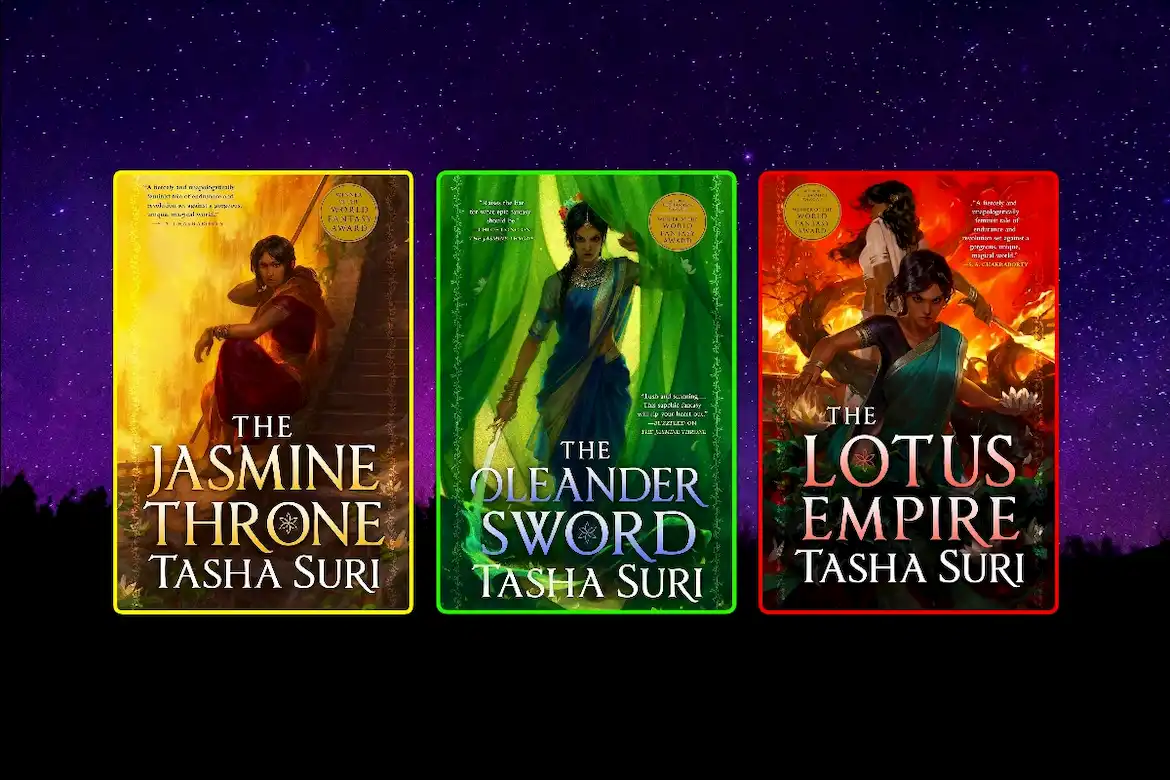Tasha Suri’s groundbreaking fantasy trilogy, The Burning Kingdoms, brings new energy and breadth to the fantasy genre. We hope you enjoy this week’s LitStack Rec.
You can find and buy the books we recommend at the LitStack Bookshop on our list of LitStack Recs.

In This LitStack Rec of The Burning Kingdoms Trilogy
Romantic, Lush, Exciting and Alive!
The Burning Kingdoms isn’t just another fantasy read. It’s a journey through a world brimming with intricate politics, ancient plant-based magic, and passionate, emotional romance. But what truly sets the series apart for me are the morally complex dual heroine characters that I couldn’t help but become emotionally attached to and invested in, their slow-burn sapphic romance, and the lush, unique and alive, Indian-inspired world that these characters inhabit.
Here are short summaries of the three books.
Book 1 – The Jasmine Throne | A Spark of Rebellion


The Jasmine Throne introduces us to a world inspired by ancient India, one deeply entwined with politics, ancient magic, and the burgeoning relationship between two powerful, but unforgettable women whose fates become irrevocably intertwined.
We first meet Malini, an imperial princess—shrewd, ambitious, and full of rage—imprisoned in the decaying temple of the Hirana by her tyrannical brother, Emperor Chandra. Her refusal to undergo a ritualistic “purification” by fire fuels her desire for vengeance and the throne, while her brother Chandra insists death by pyre is her duty and, indeed, her sacred and sanctifying fate.
It’s here in the lonely rooms of the Hirana that Milani encounters Priya, a seemingly ordinary maidservant who secretly possesses a powerful, forbidden connection to the ancient plant-based magic of Ahiranya. This magic, linked to blue “deathless waters,” is crucial to combating a mysterious “rot” spreading across the land, a rot where plants begin to grow and fester inside (and outside of) the body. Malini quickly recognizes the potential in Priya’s hidden magic power not only for escape but for her (second) planned rebellion against her brother.
The two women form an uneasy, yet increasingly intimate, alliance. As Priya explores the Hirana’s secrets, driven by a desire to understand her own past and the history of her people, she uncovers the truth about the temple’s magic and the subjugation of the Ahiranyi. The story of these two women joining forces is captivating. Two strong women, from vastly different worlds, must find common ground and act on a shared purpose.
Beyond Malini and Priya, we also meet a fascinating cast of supporting characters. Pramila, one of Malini’s caretakers in her prison in the Hirana temple, has been charged with administering poison to Malini on behalf of Emperor Chandra, Malini’s brother, who wants to weaken Malini’s resolve, forcing her to willingly submit to the pyre ritual.
Emperor Chandra embodies oppressive imperial power; Bhumika, a pragmatic and politically savvy woman becomes a key ally; Ashok, a leader of the Ahiranyi rebellion; and Malini’s loyal general, Rao, whose intimate but sexually unconsummated relationship with Malini’s older and more sensitive brother, Aditya, provides a tragic yet inspiring counterpoint to the trilogy’s central romance.
Book 2 – The Oleander Sword | War and Unforeseen Burdens


With The Oleander Sword, the emotional stakes in the trilogy skyrocket as the world expands and the central conflict deepens, focusing on a brutal escalating civil war of sister vs. brother and the immense burdens that come with power. While yet even beneath this central conflict, a wider, more lethal conflict simmers.
The rebellion against Emperor Chandra explodes into a full-scale civil war, with Malini, now a declared empress, leading her forces in a ruthless campaign to claim the throne. Meanwhile, the mysterious “rot” plaguing the land intensifies, becoming an urgent and dangerous threat. Priya, now fully embracing her role as a Thrice-Born priestess and Elder of Ahiranya (she has survived the deathless waters three times), dedicates herself to combating the rot and securing her people’s independence. As the paths of these two women diverge, their destinies are revealed to be deeply intertwined, highlighted through poignant letters and magical dreams.
Emperor Chandra unleashes a terrifying new weapon (a weapon thought to be an ancient unthinkable weapon). The worsening rot hints at the awakening of ancient, powerful entities known as the Yaksa. Both Malini and Priya face immense pressures and make difficult, often morally ambiguous, sacrifices. Malini manipulates allies and grapples with patriarchal expectations, while Priya contends with the growing power within her and the demands of leading a burgeoning nation. Their transformations in this book are truly compelling. For a second book, it doesn’t suffer from the usual weighed down plotting and trilogyitis that many middle-trilogy books suffer from. It is a solid, exciting read, and launches you into the third and climactic final book of The Burning Kingdom.
Book 3 – The Lotus Empire | A Climactic, Heart-Stopping Conclusion


The Lotus Empire brings the trilogy to its climactic conclusion, the characters confronted with the true cost of power, and ancient powerful threats that threaten to consume their worlds.
Malini has claimed the imperial throne, but her reign is tenuous, facing fierce resistance from a powerful priesthood bent on seeing Malini submit willingly to the pyre sacrifice. Meanwhile, Priya, having fully embraced her power, finds herself at odds with Malini due to the growing influence of the awakened Yaksa—ancient, often monstrous, nature spirits connected to Ahiranyi magic. The Yaksa begin to assert their will, seeking to transform the world into the second “Age of Flowers.” Their concern is not for any person, but only for their lush, plant-based world.
Malini’s and Priya’s shared goals become complicated by their conflicting loyalties and the escalating threat of the Yaksa, straining their relationship even as they desperately long for one another. The “rot” is revealed to be a manifestation of the Yaksa’s transformative power, threatening both empires with complete dissolution. The climax sees Malini seeking a weapon against these immortals while Priya grapples with the sacrifices the Yaksa demand. Despite their differences, they must try and face this existential threat together, even if it means one of them must kill the other.
The conclusion is a bittersweet resolution, far from a traditional “happy ending,” but one that emphasizes human agency and the willingness to break cycles of violence. It’s profoundly satisfying and earned, acknowledging the lasting impact of war and sacrifice while still offering hope for a future forged through their choices.
Deep Dives And Unforgettable Connections
Beyond the thrilling twists and turns, what truly sets this trilogy apart are the profound themes it explores and the rich tapestry of its world. The themes of empire, colonization, and rebellion are fully realized. Tasha Suri tackles the brutal impact of imperial expansion and the struggle for liberation, exploring perspectives from both the oppressor and the oppressed..
For those seeking powerful feminist narratives, Malini’s journey resonates as she fights against a patriarchal system designed to control her and to ultimately force her to sacrifice herself to fire. The series celebrates female strength and ambition in diverse forms.
And yes, the central sapphic romance between Malini and Priya is exquisitely rendered. It’s a foundational element of the series, exploring love and intimacy within a complex social fabric. The love scenes between Malini and Priya don’t constrain themselves to mere physical encounters, they go much deeper into the dynamics of emotions, with sharp yet tender dialogue, lending the relationship a palpable tension that brims with emotional intimacy.
The plant-based magic of Ahiranya, deeply connected to the natural world and “deathless waters,” is both beautiful and terrifying, creating a richly satisfying sensory experience. You can see, smell, taste, hear and feel this world. It is fresh and unique in the fantasy trilogy landscape. The vibrant and detailed worlds of Parijatdvipa and Ahiranya, are inspired by Indian history and mythology, and offer a refreshing departure from the standard Eurocentric fantasy tropes.
Tasha Suri Weaves True Magic
The Burning Kingdoms trilogy has received significant acclaim, and for good reasons. Tasha Suri displays a keen confidence and ability in crafting complex, ambiguous and yet relatable characters; the human flaws, struggles, and growth of the characters make them feel real and compelling. Suri’s use of a close point of view engages the reader on a more intimate, participatory level, where the author avoids telling us what a character’s emotions are and instead allows the reader to learn of and even infer those emotions. Happily, for this reader, the trilogy’s focus remains on powerful, ambitious, and multifaceted women who defy traditional fantasy tropes, women who are persistent yet vulnerable, who are resilient, and who use strategic thinking.
The intricate political scheming and court drama keeps you absorbed as well, and the lush prose and sensory details make the books seem to surround you with the living spices and flavors of their worlds. Tasha Suri’s writing is engaging, evocative, and sensual, immersing the reader in vivid descriptions.
The Burning Kingdoms trilogy books offer a powerful and emotionally resonant story populated with well-developed characters, in particular the two central women characters of Malini and Priya, and their challenging yet satisfying romance, all set within beautifully imagined and culturally rich worlds that engage all our senses.
If you’re a reader who loves fantasy series that challenge you, move you, and ultimately leave you turning pages as fast as you can, then pick up The Burning Kingdoms today. It is unlike any fantasy trilogy I’ve read, utterly unique. Trust me, you won’t regret the incredible journey and vibrant flavors of The Burning Kingdoms!
~ J.S. Hood
About Tasha Suri, Author of The Burning Kingdoms Trilogy

Tasha Suri is the award-winning author of The Isle in the Silver Sea, The Books of Ambha duology, The Burning Kingdoms trilogy, What Souls Are Made Of, and Doctor Who: The Cradle. She has won the Best Newcomer (Sydney J. Bounds) from the British Fantasy Society and the World Fantasy Award for Best Novel. Once a librarian, she is now a part-time writing tutor and a full-time cat and rabbit wrangler. She lives with her family in a mildly haunted house in London.
You can connect further with Tasha Suri on her website, on Instagram, and on TikTok.
Publisher: Orbit, Hachette Nook Group
ISBNs: Trade Paperbacks:
Book One 9780316538510; Book Two 9780316538565; Book Three 9780316538602
Buy The Burning Kingdoms Trilogy

Other LitStack Resources
Be sure and look at our other LitStack Recs for our recommendations on books you should read, as well as these reviews by Lauren Alwan, and these reviews by Rylie Fong, Allie Coker, and Sharon Browning.
Comment Using Emote
You can find and buy the books we recommend at the LitStack Bookshop on our list of LitStack Recs.

As a Bookshop, Malaprop’s, BAM, Barnes & Noble, Audiobooks.com, Amazon, and Envato affiliate, LitStack may earn a commission at no cost to you when you purchase products through our affiliate links.




